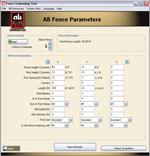Technical Newsletter
Issue 9
Project Information
Name:Mount Pleasant Fence
Product:AB Fence
Size: 3000 ft (915 m) long, 12 ft (3.7 m) tall
Allan Block Manufacturer: Block USA, Atlanta, GA

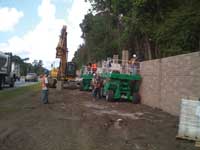
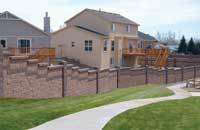
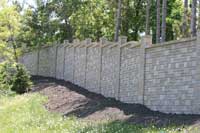

AB Fence Gets a Passing Grade From SCDOT
As with any community that once considered themselves small, the community of Mount Pleasant, South Carolina has seen major population growth over the years. With this growth the traffic congestion and noise have continued to increase to a point that South Carolina Department of Transportation (SCDOT) traffic studies gave the US 17 corridor a ‘D’ Grade. This poor grade was only projected to get worse, forcing the SCDOT and the city to develop a plan to expand and upgrade the corridor. The upgrade was not only to relieve traffic congestion but also to reduce the increasing noise problems to the surrounding residential neighborhood. Mount Pleasant had no sound walls anywhere in the city and for their first they wanted to set a high quality standard. The city chose the AB Fence System with the four block Ashlar Blend Pattern for its aesthetic quality, its performance in reducing noise and its competitive cost.
The SCDOT and city engineers worked closely together during the planning process to develop a solid plan. The design followed the AASHTO Guide Specifications for Structural Design of Sound Barriers. Steven Johnson of George A. Z. Johnson, Jr., Inc., used the AASHTO wind loading of 90 mph, multiplied by a customary 30 % increase for wind gusts for his final design. The design of the posts and panels followed Allan Block’s Fence Engineering Manual, which calls for structurally reinforced columns and dry-stacked block panels with predetermined courses reinforced and cast solid as bond beams. The system works as a traditional post and panel system with the panels transferring loads laterally to the posts and the posts transferring loads to the drilled shaft footings. Due to the larger coastal wind loads and AASHTO requirements, the project utilized the Allan Block Large Post Block, which greatly increases the post capacity.
Because this was the first AB Fence project for general contractors, Gulf Stream Construction, they invited an Allan Block Project Specialist to the site to train their installers. The installation crew caught on quickly and were off to the races. They followed the AB Fence Installation Guide closely and brought in a few of their own tricks along the way while maintaining the high quality of the system.
Due to the tight schedule, Gulf Stream decided to mass-produce the bond beams by precasting them off-site and trucking them to the site. Because the project called for the AB Ashlar Blend Pattern with random blocks flipped back and forth for added facial texture, extra time was required to achieve the high aesthetic quality of each panel. To reduce installation time and maintain a consistent pattern, Gulf Stream had the same crew that built the bond beams also place the dry-stacked pattern block at the site that go between each bond beam.
The speed at which the AB Fence System can be installed was one of the many factors that made this project such a success. The City of Mount Pleasant was so happy with the overall project that the AB Fence System has been chosen for their 2011 US 17 expansion project which includes 4 separate walls totaling over 55,000 square feet. For more information on this story, check out the Mount Pleasant Fence case study.
Estimating & Construction Tips for AB Fence
A successful construction project starts with a thorough and solid plan. It is important to consider site elements that will impact your construction activities. Here are a few to consider:
Layout: Because the AB Fence System is like any other post and panel fence system, care must be give to the layout of the post locations. This is the most important step since proper layout will ensure that the posts are located correctly and panel modifications are not required; thereby, saving you time and money. You can follow the complete construction steps starting with layout here.
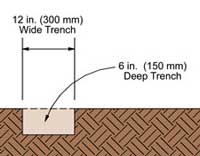
Soil Conditions: The underlying soil will influence the size, both in diameter and depth, of your post footings. The type of soil will also impact your efficiency. For example, granular material will provide better support and may not require as large of a footing, but will be harder to form the concrete piles.
Site Access: Typically fences are constructed at or near property lines. Therefore, determining if there will be access to both sides of the fence during construction is a very important consideration because that is where construction activities and material storage can take place.
Grade Changes: Additional planning must be done anytime there are step ups/downs within the fence. Grade changes are easily accommodated by the AB Fence System, but modification may be made within a panel section if steep grade changes are encountered.
Articulations within the Fence: The AB Fence System has the flexibility to create gradual curves with the connection between the post and panel, but sharp bends may require the use of the corner block.
Fence Height: When constructing the AB Fence it is important to remember that scaffolding will be required to gain access to the top of the wall. Installing the top courses of block, constructing bond beams and finishing with caps must always be done safely.
Underground Structures / Utilities: There are many ways this can impact your fence project. Obviously, part of this is for safety,but the other part is how these underground structures may impact the design. Different panel lengths can be made to avoid any “underground” problems. Always call for utility locations before digging.
Allan Block has millions of AB Fence units installed on hundreds of projects in North America. The AB Fence has proven to be a valuable solution to the fencing market and should be one that can be considered on your next project. Click here for more detailed information on proper fence installation.
AB Fence Project Development Tools
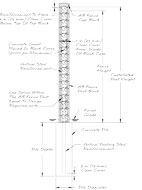
AutoCAD
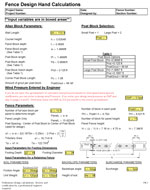
Mathcad
Mathcad design calculation templates: Easily design your AB Fence with the help of this design aid. Simply input all the site parameters and check to see if the minimum factors of safety are met.
AutoCAD design details: Use these design templates to save time developing your construction documents, all you need to do is customize these details and specifications to meet your site needs.
AB Estimating Tool: The AB Estimating Tool can estimate material quantities for your AB Fence project. This is especially helpful when trying to estimate a fence using the AB Ashlar Blend Pattern.




